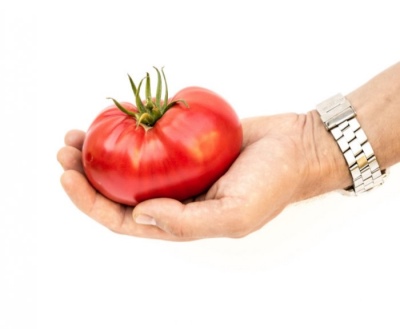
- Authors: Kiramov O.D.
- Year of approval: 2017
- Category: hybrid
- Growth type: indeterminate
- Appointment: fresh consumption
- Ripening period: early
- Ripening time, days: 105
- Growing conditions: for open ground, for film greenhouses
- Leaves: long, green
- Unripe fruit color: green with a dark spot
One of the newest representatives of beef tomatoes is the indeterminate hybrid Pride of the Feast, grown in the open field, as well as in all types of greenhouses. Fleshy pink fruits are great in fresh salads, ideal for juices and sauces, and are also used in winter salads.
Breeding history
The hybrid was approved for use in 2017, the author is the breeder Kiramov O.D.
Description of the variety
The hybrid, under the obligatory name Pride of the Feast, lives up to the name with honor. Tall bushes reach majestic sizes of 200 cm and more. The roots give liana-like shoots that need constant tying, because they have to not only withstand their own weight, but also a lot of ripening tomatoes formed by clusters with 3-5 fruits on intermediate inflorescences. The first inflorescence is laid over the 9th leaf, all subsequent ones alternate every two cuttings of the leaf plate.
The main qualities of the fruit
Green, in an immature state, large flat-round, slightly ribbed fruits are colored in a bright red intense color. The weight of one tomato is 320-330 g, a cut shows a small number of seed chambers with small seeds. The fruits tend to ripen along the entire length of the shoot.
Taste characteristics
The pulp is juicy, has a dense structure and a balanced taste with excellent indicators of sugar content and acidity.
Ripening and fruiting
The plant belongs to early ripening: the approximate ripening of fruits is 105 days. However, they can move slightly to one side or the other, depending on weather conditions. Fruiting is characterized by a prolonged period, so the harvest is harvested for a long time.
Yield
The pride of the feast gives rise to pride not only in the taste and beauty of the fruits, but also in the yield - from 12 to 14 kilograms of magnificent tomatoes are harvested from one square meter.
The timing of planting seedlings and planting in the ground
Seeds are sown in early or mid-March, the grown seedlings are transplanted to a permanent place after 55-60 days.

Growing tomato seedlings is an extremely important process, because it largely depends on whether the gardener will be able to harvest at all. All aspects must be taken into account, from seedbed preparation to planting in the ground.
Landing scheme
The optimal distance between the roots is 4 plants per sq. m.

Growing and care
Sowing seeds for seedlings is carried out with pre-disinfected material - the seeds are treated with a pink solution of potassium permanganate or ready-made stimulants (Epin-Extra, Citron, HB101 and others). Mature hardened seedlings are transplanted into place a couple of months after sowing. The soil should be fertile, with good aeration properties and sufficient light. The acidity level is close to neutral. Acidified soils are deoxidized with dolomite or bone meal, as well as lime fluff. If a permanent trellis is not installed in place, it can be replaced with high stakes or stretched cords, which are increasingly used in greenhouses.
After transplanting, caring for a tomato consists in forming a bush into 1 stem, pinching and breaking off excess foliage. These activities will provide ventilation of plants and free access of fresh air. Equally important are regular watering, weeding, loosening and hilling, timely feeding, airing greenhouses, and constant monitoring of humidity in confined spaces. Its increased level can and will almost certainly provoke the appearance of late blight, slugs. And also a preventive fight against possible pests and diseases is necessary. The introduction of dressings is mandatory, since the development and fruiting depends on the amount of nutrients in the soil. The first feeding is carried out 2-3 weeks after planting in the ground. At this time, intense flowering begins, and the tomatoes need nitrogen fertilizers. During the budding period, they need potassium-phosphorus preparations. In addition, throughout the season, the hybrid is fed with mullein or nettle infusion.




A plant needs different micronutrients at each stage of growth. All fertilizers can be divided into two groups: mineral and organic. Folk remedies are often used: iodine, yeast, bird droppings, eggshells.
It is important to observe the rate and period of feeding. This also applies to folk remedies and organic fertilizers.
Disease and pest resistance
The hybrid is quite hardy, fights against diseases such as top rot, tobacco mosaic virus (TMV), and is tolerant to some others. In addition, there is always a real threat of damage to plants by insect pests. To avoid all sorts of plant health problems, you need to carry out prophylaxis with both fungicides and insecticides.


Resistant to adverse weather conditions
The pride of the feast is intended for cultivation both in warm areas and in more northern regions, therefore it tolerates a dry period and short-term cold snaps quite well.
Growing regions
It is adapted to the conditions of any climatic zones of our country, these are the northern, northwestern, central, Volga-Vyatka regions, the Central Black Earth Region, as well as the North Caucasian, Middle Volga, Lower Volga, Ural, West Siberian, East Siberian, Far Eastern regions.
Review overview
A study of gardeners' reviews shows that most of those who once planted this hybrid left it in their collection. The value of the plant for users is in its large fruit size and a large number of full-fledged fruits on one bush, as well as in its early yield. Disease resistance of tomato is equally important.

























































































